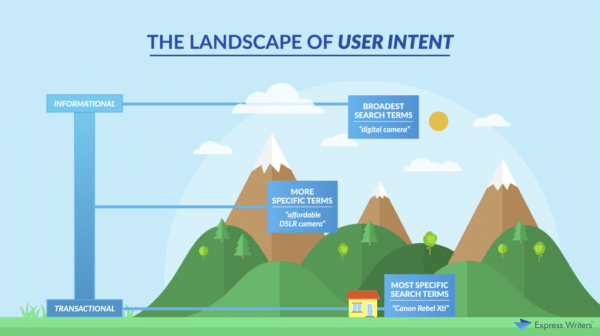If you know anything about search engine optimization (SEO), you know that search engines prefer high-value content that’s most relevant to the user’s intent. So, the more valuable the content is to the user, the higher it will rank in search results.
Unfortunately, many companies and brands focus too much on the technical side of SEO to craft compelling content that will result in higher traffic.
Thankfully, mastering SEO copywriting can be enough to move the needle and generate the results you need to build stronger brand recognition.
But what does it mean to use SEO copywriting, and which tips can help you make the most of it? Get your typing fingers ready, and let’s dive in!
- What Is SEO Copywriting?
- 7 Ways to Leverage SEO Copywriting to Dominate Search Results
- Wrapping Up
Download this post by entering your email below
What Is SEO Copywriting?
SEO copywriting is the process of incorporating search engine optimization techniques into copywriting content creation.
In a practical sense, SEO writing means researching new keywords and then generating content ideas based on them. In this case, everything from the title of the content to the headers and subheaders is optimized around a specific keyword.
7 Ways to Leverage SEO Copywriting to Dominate Search Results
When done correctly, effective SEO copywriting can improve your brand’s search visibility and help you rank higher for your target keywords.
However, to get the most out of each content piece, you need to do more than just add related keywords and type some generic text about the topic.
Instead, here are seven surefire ways to ensure your copy is as optimized as possible, so you rank as highly as possible in SERPs.
1. Conduct comprehensive keyword research
At first, you may assume that the best keywords are those that receive tons of traffic. However, while you want to target high-profile keywords, you have to remember that everyone will be trying to capture the same traffic.
So, the more interest surrounding a keyword, the more competitive it will be (and harder to rank for).
Alternatively, it’s best to focus your attention on similar keywords that may address specific queries or niches within your industry.
For example, instead of trying to rank for SEO marketing, you may focus on ranking for a keyword like “SEO tactics for small e-commerce businesses” or “How to Use SEO for Building a Blog From Scratch.”
Since keyword research is the foundation of your SEO copywriting strategy, you need to spend a lot of time developing and curating keywords for your site.
Each one should be relevant to your product offering, valuable for your target audience, and have enough traffic to boost your online engagement.
Once you have a sufficient list of top-level keywords (i.e., those that can be used in an SEO-friendly title), you can use AI keyword generator tools to come up with related words and topics. These additional keywords will help you flesh out an outline for each topic and dive deeper to generate more valuable content.
Pro Tip
You should generate both deep-level and surface-level content.
Deep content will discuss complex topics and various sub-topics to help the reader understand them. This content will usually go about 2,000 words or more.
Surface-level content will focus on a single keyword or aspect of your niche, and it should be about 500 words.

2. Analyze the top-competing content pieces for the same keyword
No matter what keyword you want to rank for, there will already be a page in the top position.
So, the best way to maximize your SEO copywriting is to see what’s already there and study it. When reviewing the existing content, be sure to ask these questions:
- Who Would Be Searching for This Keyword?
We’ll get into audience research in the next section, but you want to get into the mindset of someone who would type this keyword string into a search engine and why.
- Is the Top Link Relevant to the User’s Needs?
Sometimes, top-ranking content exists because there’s nothing that addresses the user’s query specifically. If that’s the case, the best strategy is to focus on answering that query as completely as possible.
If the top link is highly relevant, you can think of creative ways to dive deeper and answer other questions the user may have.
- Is the Top-Ranking Content Good?
You don’t necessarily have to read the entire piece, but you should get a sense of how easy it is to read and whether it provides sufficient information about the query. If not, you can often rank higher by generating something better, even if the topic is almost identical.
- How Recent Is the Top Post?
Sometimes, a piece can stay in the top position even if it’s more than five or 10 years old.
Since users often want more recent information, your content could outrank the older version by adding new details or context that may have developed from then until now.
Overall, the reason to look at the content listed under specific keywords is to determine how you can make something more valuable to the intended user.
Even if a piece is well-written, you may be able to find another angle or add some more panache to the writing to make it more engaging.
3. Understand your user’s search intent
As we mentioned, search engines rank content based on how valuable and relevant it is for the user. Over the decades, Google has refined its algorithm to try to understand the user’s intent as clearly as possible.
Even though you don’t have access to this algorithm, you can still do audience research to figure out how to create more valuable content for your target demographic. When crafting a new piece, be sure to answer these questions:
- Why would my target demographic be searching for this content?
- What would this person hope to gain from this piece?
- How much research has this person done on the topic already, and how valuable is this content compared to what they’ve already seen?
- Does this content provide sufficient information for the user, or will they need to search for additional content related to this topic?
Overall, the more detailed you can get about your user’s intent, the easier it is to write from that perspective. Then, you can generate high-value content that will keep their attention focused on your brand.

4. Don’t forget about the on-page SEO details
Although value and relevancy are crucial for top-ranking SEO copywriting, they’re not the only elements to pay attention to when crafting a new piece.
There are also tons of smaller details to get right if you want your content to rank in one of the top three positions. These details can include the following:
- Meta Title
This is the title that will show up in the search result link. So, you want to make the meta title compelling and relevant by interestingly using the main keyword. The more creative the title, the more likely someone will click on the link.
- Meta Description
This text goes underneath the title in the search results, and it provides some additional context about the piece. While you want to optimize this section with keywords, the main purpose is to tell the reader why they should click the link and read your post.
- Image Tags and Captions
To make your content more interesting, you should incorporate photos and graphics into the text.
However, search engines pay attention to these images, so you have to make sure they’re optimized for your target keyword. For example, an image filename of 120LK.jpg is not as effective as SEOmarketinginfographic.jpg.
- URL Slug
The slug should match the title of the article, so there’s no confusion regarding what the content is about. In both cases, you should use the same top-level keywords for better consistency.
5. Incorporate internal and external links
This is actually another on-page SEO essential. When creating SEO-optimized copy, make sure to include both internal and external links strategically.
Internal links connect different pages within your website, allowing search engines to understand the structure and hierarchy of your content. It also helps users navigate your site and discover related information.
External links, on the other hand, point to authoritative and relevant sources outside your website, adding credibility and context to your content.
By incorporating a mix of internal and external links, you can enhance the user experience, improve search engine visibility, and establish your content as a valuable resource.
6. Prioritize page speed and user experience
Ensure that your website offers a smooth and fast user experience. Page speed is a crucial factor for search engine rankings, as users tend to abandon websites that load slowly.
Optimize your website by compressing images, minimizing code, and leveraging caching techniques. Consider using a content delivery network (CDN) to ensure faster loading times across different locations.
By prioritizing page speed and user experience, you can improve your website’s performance in search results and enhance user satisfaction.
7. Hire professional SEO copywriters
If you’re not a copywriter, creating new posts from scratch may seem overwhelming, especially when you realize how much content you should be posting.
Fortunately, you don’t need to be a professional writer to get the best content. Instead, you can outsource the writing to freelancers who know your industry inside and out. Even better, sites like WriterAccess can use AI technology to connect you with these copywriters, so you don’t have to do the research yourself.
In this case, all you have to do is keyword and competitor research and let the writer take care of the rest.
Relying on experienced copywriters ensures you can craft better content than what already exists, and you know it will read easier and seem more compelling. Plus, you can tell the writer to add any extras, like personality or research-heavy context.
Wrapping Up
Are you ready to see how SEO copywriting can propel you to the top of the search results pages?
WriterAccess and Rock Content make the process as easy and painless as possible. Plus, when you take advantage of our free two-week trial, you can get the results without having to invest an arm and a leg.
Why wait? Try it now!








